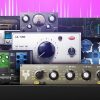-
 play_arrow
play_arrow
Clubalicious Clubalicious Radio
-
 play_arrow
play_arrow
London Calling Podcast Yana Bolder

Appalachian State University in Boone, NC was somewhat ahead of the curve, building out a Dolby Atmos control room even before Apple took immersive music mainstream with its Spatial Audio service. Being in the vanguard came with challenges, admits Scott David Wynne, professor and chief recording engineer at the school’s multi-room Robert F Gilley Recording Studio. “We had the same growing pains as everybody else did—but we did find out we could effectively teach the Dolby renderer with binaural on headphones and it would do a reasonable job.”
The focus of the immersive room was postproduction and game sound, he continues: “My students and I built it to be effective and efficient. We didn’t want a control surface; we had a keyboard and a mouse, with the renderer on the computer.” Dolby provided a license that the school put in the cloud, enabling students to learn Atmos mixing at home.
However, it soon became clear that automating Atmos mixes by mouse was not ideal, so Wynne and the students installed an Avid S6 console and added a Genelec 7.1.4 monitor setup. “It was a great experience for the students, because they got to see how all the components go together, and interact with the manufacturers,” he says. “We really take the time to teach the students all the steps and the flaws—and let them see us make mistakes as well.”
Involving students in the process also teaches them that not all job opportunities are necessarily in the studio: “If you are excited putting together S6 modules, you could get a job with Avid.”
Sound with picture is important to the school, Wynne says. Where immersive music is concerned, there are lessons to be learned from the jump from mono to stereo and stereo to 5.1, he believes. “We need composers, artists, producers and content creators to start thinking about this immersive format. What are the problems that [immersive music] creates? What are the creative avenues that we can take? How do we create an envelope in an environment that also translates to earbuds? Content creators need to start thinking about how, musically, they want to write the parts— but I don’t know that they are thinking that far ahead.”
Meanwhile, Wynne and the students have gutted Studio B, a 5.1 mix suite, and, in collaboration with acoustician Wes Lachot, are readying it for a new 64-channel API Vision console. After that, Wynne hopes to build an immersive broadcast room around an existing Lawo mc²56 desk to stream the school’s 200 annual concerts in stereo and binaural. “We may mess up, but it’s an educational facility, and we’re trying to expand what we do and give the students all these great experiences,” he says.
CONTINUE ON TO PART 5
Written by: Admin
Similar posts
Recent Comments
No comments to show.Featured post

Latest posts
Current show
Upcoming shows

In Session
Sister Bliss
16:00 - 17:00
Finnish Dance Chart
Top 40 Hottest Dance Tracks In Finland
17:00 - 19:00
Made To Move
Jacob Colon
19:00 - 20:00
In Session
Sister Bliss
20:00 - 21:00
Fresh Is Fresh
This Weeks Hottest Releases
21:00 - 00:00Chart
Powered by Dee jay promotions visit us













 Invalid license, for more info click here
Invalid license, for more info click here